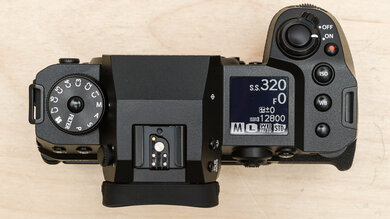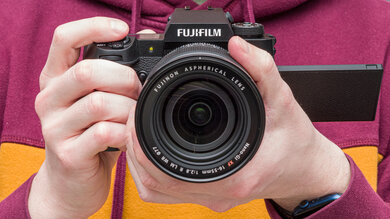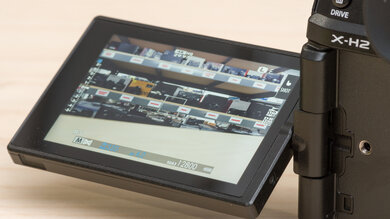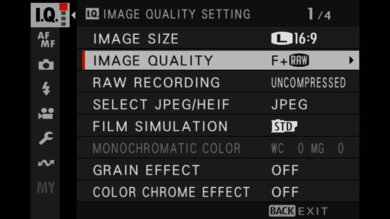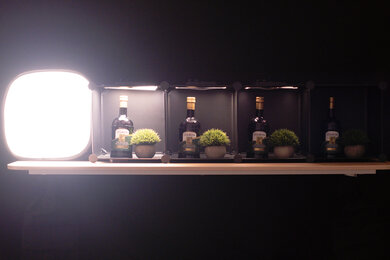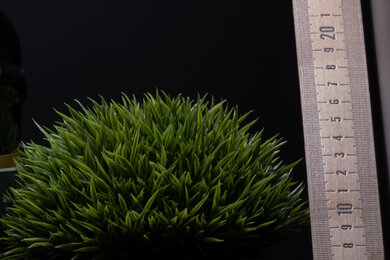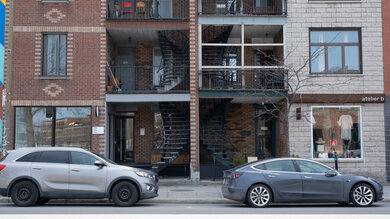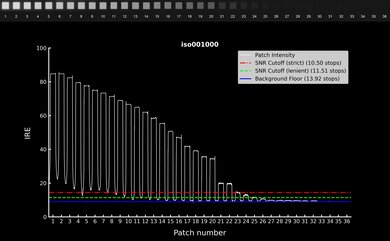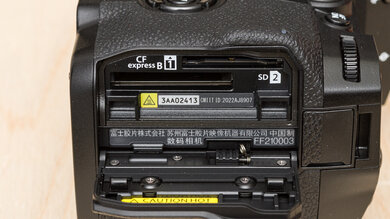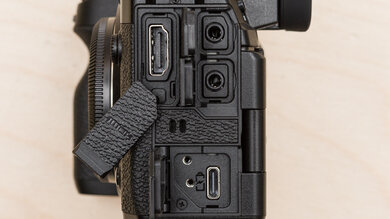The Fujifilm X-H2 is one of two flagship models in Fuji's mirrorless APS-C lineup. In contrast to the high-speed Fujifilm X-H2S, which uses a stacked sensor with a faster readout speed, the X-H2 has a higher-resolution 40-megapixel backside-illuminated sensor and 8k video recording, making it a powerhouse for high-resolution stills and video. While it lacks the dedicated exposure dials and vintage aesthetic that Fuji fans are used to with the X-T lineup, the X-H2's sturdy weather-sealed body, large grip, and relatively long battery life are great for long days of extensive use.
Our Verdict
The Fujifilm X-H2 is good for travel photography, especially if you prioritize image quality over portability. It isn't very small or lightweight, but its high-resolution sensor can capture stunningly detailed images. In-body image stabilization makes it easier to capture photos at slower shutter speeds. The camera is also sturdy and weather-sealed to give you peace of mind when shooting outdoors. Battery life is also great for a mirrorless camera. However, it isn't the best option for low-light situations.
- Sturdy, weather-sealed construction.
- High-res sensor produces incredibly detailed photos.
- Great battery life.
- Not very portable.
- Low light noise handling is just okay.
The Fujifilm X-H2 is great for landscape photography. Its high-resolution sensor captures an incredible amount of detail, which is great for making large-scale prints and gives you more leeway to crop in your photos. Dynamic range is superb, so it can capture a wide range of shadow and highlight detail. It doesn't have the greatest noise handling in low light. It also isn't the most portable camera.
- Sturdy, weather-sealed construction.
- High-res sensor produces incredibly detailed photos.
- Wide dynamic range.
- Great battery life.
- Not very portable.
- Low light noise handling is just okay.
The Fujifilm X-H2 is great for sports and wildlife, though the high-resolution sensor best suits static subjects. Its slow readout speed means shooting at its fastest burst rate with the e-shutter can cause rolling shutter artifacts. On the upside, its max mechanical burst rate is still fast. It also has an effective autofocus system with various subject-tracking modes that work well. Battery life is solid, too. Its photo buffer is surprisingly large, considering the file sizes from that high-res sensor, though working with such large files may not be preferable when shooting extended bursts.
- Sturdy, weather-sealed construction.
- High-res sensor produces incredibly detailed photos.
- Great battery life.
- Quick burst shooting.
- Large photo buffer.
- Not very portable.
- Slow readout speed can cause distortion with e-shutter.
- Low light noise handling is just okay.
The Fujifilm X-H2 is decent for vlogging, but this isn't its intended use. It's mostly suited for sit-down vlogs, as it's not portable enough for on-the-go vlogging. On the upside, its fully articulated screen makes it easy to monitor your footage when self-recording. It also has plenty of frame rate and resolution options. Rolling shutter distortion can be an issue if you pan the camera rapidly.
- Fully articulated screen.
- Amazing video quality.
- Not very portable.
- Noticeable rolling shutter effect.
The Fujifilm X-H2 is excellent for studio video. It can record in a wide range of resolutions, including 8k, 6.2k, oversampled 4k, and sub-sampled 4k. Video quality is amazing, with excellent dynamic range, and the camera has a very effective subject-tracking feature. It can also output RAW video to a compatible external recorder via HDMI and supports 10-bit 4:2:2 video internally, including support for ProRes codecs when using a CFexpress card slot. That said, while battery life is generally good, it can overheat during longer recording sessions, especially when recording in 8k. It also suffers from rolling shutter distortion, which can be problematic with panning shots and quicker camera movements.
- Video recording up to 8k.
- RAW video output via HDMI.
- Internal ProRes 422 codec support.
- Amazing video quality.
- Noticeable rolling shutter effect.
- Can overheat during longer recording sessions.
The Fujifilm X-H2 isn't meant for POV-style action video. That said, it's a very capable video camera for recording high-resolution sports or action footage from the sidelines. It has a lot of frame rate options, with 8k up to 30 fps, 4k up to 60 fps, and 1080p up to 240 fps in its FHD high-speed recording mode. That said, rolling shutter distortion can cause artifacts with quicker camera movements.
- Sturdy, weather-sealed construction.
- Amazing video quality.
- Plenty of frame rate options.
- Not portable enough for POV action footage.
- Noticeable rolling shutter effect.
- Not waterproof.
The Fujifilm X-H2 has great RAW photo performance. Its exceptionally high-resolution sensor gives you a lot of room to crop in without losing detail. It also has incredible dynamic range, so it captures a very wide array of highlight and shadow detail. It doesn't have the greatest noise handling in low light.
- High-res sensor produces incredibly detailed photos.
- Wide dynamic range.
- Low light noise handling is just okay.
Performance Usages
Changelog
-
Updated Dec 12, 2024:
We wrote text for the new tests added in Test Bench 0.13 and updated the Verdict section accordingly.
- Updated Dec 12, 2024: We've converted this review to Test Bench 0.13. We've added new tests for Video Dynamic Range and Luminosity Patch Detection. You can learn more about these updates in the changelog.
- Updated Jan 29, 2024: Added text to the 'Raw Photo Performance' verdict box.
- Updated Jan 29, 2024: Converted to Test Bench 0.12.1.
Check Price
Differences Between Sizes And Variants
The Fujifilm X-H2 comes in one color: Black. You can see our unit's label here. You can buy the camera body on its own or bundled with a single kit lens, like the XF 16-80mm f/4 R OIS WR zoom lens, or multiple lenses, depending on the retailer.
Having said that, Fujifilm has a list of recommended lenses to use with this camera to take full advantage of its high-resolution sensor. These are Fujifilm lenses that have the best edge-to-edge resolving power at max aperture. However, Fujifilm also notes that even if you use a lens not listed here, you'll still see the effects of its high-resolution sensor; it just may not be the sharpest possible image.
We purchased the Fujifilm XF 16-55mm f/2.8 R LM WR lens, which is included on the list of recommended lenses, to test the camera with (excluding our image quality tests, for which we use a standardized lens for comparability across reviews). You can see a sample photo taken with the XF 16-55mm f/2.8 R LM WR here, compared to a sample photo taken with the XF 18-55mm F2.8-4 R OIS (not included on the list of recommended lenses) here.
Let us know if you come across a different variant, and we'll update our review.
Popular Camera Comparisons
The Fujifilm X-H2 is a high-end APS-C camera. It has a high-resolution sensor that lets it capture remarkably detailed photos compared to other APS-C offerings, along with 8k video recording, giving many cameras in a similar price range a run for their money. However, its slow readout speed can be an issue when taking photos or shooting video of faster subjects. By contrast, its sister model, the Fujifilm X-H2S, uses a lower-resolution stacked sensor with a faster readout speed that allows it to shoot at very quick burst rates with less rolling shutter effect and no EVF blackout. Though the cameras look and feel identical in terms of build quality and ergonomics, the X-H2 is better suited to studio work, portraits, and landscapes, while the X-H2S is better suited to situations where speed is a priority, like weddings, action photography, and video.
For more options, check out our recommendations for the best mirrorless cameras, the best cameras for landscape photography, or the best cameras for filmmaking.
The Fujifilm X-H2 and the Fujifilm X-H2S are both amazing APS-C cameras with identical builds, but they use different sensors geared toward different uses. The X-H2S has a stacked 26 MP sensor that's ideal for video and action photography thanks to its faster readout speed, which allows for blackout-free burst shooting and minimizes rolling shutter effect. The X-H2, on the other hand, uses a higher-resolution 40 MP sensor that makes it better for portraits and landscapes, giving you plenty of leeway to crop and edit your photos. Both are also extremely capable video cameras, though the X-H2 can record 8k video while the X-H2S caps out at 6.2k. However, the X-H2S's faster readout means less rolling shutter distortion in video.
The Fujifilm X-H2 and the Fujifilm X-T5 share the same high-resolution APS-C sensor, but they have differently designed bodies aimed at different users. The X-T5 is more portable and has a tilting screen, making it a good fit for street photography or those who want a lighter, smaller body. It also has dedicated exposure dials that make adjusting settings on the fly easy. The X-H2, on the other hand, has a standard PSAM dial and a chunkier body that's aimed more at pros and hybrid shooters.
The Sony α7 IV and the Fujifilm X-H2 are both high-end hybrid cameras, but they use different-sized sensors. The Sony has a full-frame sensor, while the Fujifilm has a higher-resolution APS-C sensor and can record 8k video. That said, the Sony is better for low-light shooting.
The Fujifilm X-H2 and the Fujifilm X-T4 are both excellent APS-C cameras, but they're aimed at slightly different users. The X-H2 is a bit more powerful, with a higher-resolution sensor, upgraded autofocus system, and video recording in up to 8k resolution. However, it's a lot bulkier than the Fujifilm X-T4, which is the better choice for users who want a more portable hybrid camera.
Test Results

The Fujifilm X-H2 isn't especially portable. It's heavier and bulkier than the Fujifilm X-T4, but it'll feel well-balanced with moderately large lenses. If you want something more portable but don't want to give up that 40.2-megapixel resolution, consider the Fujifilm X-T5, which uses the same sensor.
The build quality is superb. It's identical in design and build quality to the Fujifilm X-H2S. Overall, it feels very durable and well-built. Fujifilm advertises it as having 79 weather-sealed points to keep out dust and moisture and says it can withstand temperatures as low as 14°F (-10°C). All of the inputs are covered with secure plastic doors, while the memory card compartment and battery compartment both have locking hinged doors. You can even remove the memory card door if needed.
Compared to the Fujifilm X-H1, the X-H2, like the Fujifilm X-H2S, has a few key design differences. The joystick on the back has been redesigned and repositioned, as you can see here. Like the Fujifilm X-S10, the X-H2 has a PSAM dial instead of the typical Fuji exposure dials you get with the X-H1. You can see how the tops of the X-H1 and X-H2 differ here.
The X-H2 has fantastic ergonomics. Though the camera is on the larger side, it feels well-balanced when shooting with a lens like the Fuji XF 16-55mm f/2.8 R LM WR and doesn't get tiresome to use for longer periods. The grip is very deep and comfortable, with a sufficiently grippy texture. That said, without dedicated exposure dials, like you get with the older X-H1 or the Fujifilm X-T4, adjusting exposure settings on the fly is not as easy. Unlike the X-T4, the command dials don't have click functionality, giving you less customizability. The rubber eyecup is also on the harder side. The joystick can be hard to reach if you have smaller hands; otherwise, the buttons and dials are well-placed.
At 5.76 million dots, the viewfinder has a very high resolution that gives you an incredibly detailed image when shooting through the viewfinder. You can set the refresh rate at up to 120fps to minimize blur and lag, though the higher refresh rate setting impacts battery life.
The Fujifilm X-H2 has a fully articulated screen, which is great for video work and makes it easy to monitor your footage if you're recording yourself. The screen has a fairly high resolution, so the image on the monitor looks quite sharp. Touch capability is limited to selecting autofocus points and shutter control. You can only use the touchscreen to change settings in video mode.
There's a secondary display on top of the camera that shows info about battery life, storage space, and settings at a glance. You can toggle it between light and dark mode.
The user interface is great. It's easy to navigate using the joystick or the directional pad on the back of the camera. It has a fairly intuitive layout, although some of Fujifilm's terminology differs from other brands, e.g., metering settings are called 'Photometry' settings. While the menu may take some time to get used to, it's easy to navigate once you get a handle on it. There's also an info function to explain certain settings. Still, it's somewhat limited, especially compared to cameras like the Canon EOS R6 Mark II, which has a more comprehensive guide function.
There's also a quick menu for commonly used settings, which you can customize. Another nice touch is that the quick menu doesn't fully obstruct your view on the screen, so you can see any adjustments as you make them. You also have customizable 'My Menu' pages for photo and video, allowing you to create a custom menu limited to the specific settings you wish to access. Overall, these extensive customization options, including swipe motions for the screen and almost all of the camera's buttons, allow you to tailor the shooting experience to your preferences.
This camera is also compatible with Fujifilm's new XApp, which is supposed to offer smoother wireless connectivity between X series cameras and smartphones than the older Fujifilm Camera Connect app. We didn't find a huge difference in performance between the new one and the old Camera Connect app, especially after the latest software updates for Camera Connect. However, the XApp is well-designed and offers plenty of functionality through Bluetooth and Wi-Fi, including use as a remote for the camera, backup for your settings, and file transfer from your camera to your smartphone (excluding RAW files). The Timeline and Activity features are neat ways to keep track of your photo history and shutter count. When connected to the camera via Wi-Fi, you can also use the app for Live View, but it can be a bit laggy, and you won't have access to every setting. The signal range is also limited and gets easily disrupted when there are obstructions between your phone and the camera. If you'd like to see the XApp in action, you can see a brief video tour of the app here.
The Fujifilm X-H2 uses a backside-illuminated sensor that Fujifilm claims has an improved pixel structure for better light-gathering ability. With this new sensor, the base native ISO is now 125, as opposed to ISO 160, which was the native base on previous cameras, including the Fujifilm X-H2S and the Fujifilm X-T4. The new X-Processor 5 is also advertised to have twice the processing speed as the previous generation.
The Fujifilm X-H2 has excellent battery life. It's CIPA-rated for 540 photos on a full charge, slightly less than the Fujifilm X-H2S. While that number is just a ballpark figure that can vary with real-world usage, it's great relative to other mirrorless models, though it falls far short of DSLR numbers.
For video, the camera lasts almost two hours of continuous video recording in 4k at 30 fps. In 8k, that drops to about an hour, which is still good considering the higher processing power required for 8k recording.
The Fujifilm X-H2 can shoot at a quick max burst rate with its mechanical shutter. E-shutter burst shooting is a little faster but has more risk of artifacts from rolling shutter. The Fujifilm X-H2S, on the other hand, is much more suited to fast continuous shooting, with a blazing fast 40 fps burst rate and a stacked sensor that minimizes rolling shutter artifacts. On the upside, the X-H2 has a large photo buffer. When shooting in JPEG with a CFexpress Type B card, the buffer clears photos quickly enough that you'll never have to worry about filling it up. It fills up after about 115 shots when shooting in RAW, which is still excellent, but not quite as large as the X-H2S, but considering the higher-resolution files on the X-H2, it's still quite impressive. However, the buffer takes about 14 seconds to clear afterward, which can slow you down. If you use a high-speed SD card instead of a CFexpress card, the RAW buffer fills up after about 70 photos, and it takes about 43 seconds to clear, which can slow you down. If you shoot in JPEG, on the other hand, the buffer is still virtually limitless.
The Fujifilm X-H2 uses a hybrid autofocus system with decent tracking capabilities. It has an automatic subject detection feature that can track human eyes and faces, animals like cats and dogs, birds, cars, bikes, airplanes, and trains. With human faces, it does a good job of keeping moving subjects in focus, but it can be somewhat inconsistent. It especially has trouble maintaining focus in busier settings, sometimes getting tripped up and shifting focus to the background. The Fujifilm X-H2S performs a little more consistently in that respect, which isn't surprising given its stacked sensor's efficiency. However, the X-H2 still has an effective tracking feature overall and improves on the AF tracking in older models like the Fujifilm X-T4. Note that after updating the camera to firmware Ver.3.00, which is supposed to improve the AF tracking algorithm, we experienced less reliable AF tracking than when we previously tested the camera.
The autofocus works very well when using a single focus point, especially when using a lens with a quick focusing motor. You'll have no trouble keeping subjects behind the focus point in focus, whether they're static or moving predictably.
The Fujifilm X-H2 has a five-axis in-body image stabilization system that the manufacturer advertises to offer up to 7 stops of compensation. We tested image stabilization using a lens without optical stabilization and still managed to capture clear handheld shots at very slow shutter speeds, so the IBIS works well to minimize the effects of camera shake.
The camera's RAW dynamic range is fantastic. It can capture a very wide range of highlight and shadow detail. It also maintains a solid amount of dynamic range in low light.
The X-H2 uses a 40.2-megapixel sensor, so it can capture an impressive level of fine detail. You have plenty of room to crop in your photos without losing too much resolution.
Thanks to the sensor's high resolution, the X-H2 can also take advantage of Fujifilm's 'Pixel Shift Multi Shot' feature, which was previously only available on some of their medium format GFX cameras. This is something you don't get with the Fujifilm X-H2S. The Pixel Shift mode takes a series of 20 RAW photos, using the camera's in-body image stabilization to move the sensor in tiny increments for each frame. Then, using the Fujifilm 'Pixel Shift Combiner' software, you can combine the images into an ultra-high-resolution composite photo of up to 160 megapixels. Here's a sample Pixel Shift photo taken of our test scene, which you can compare with the standard test scene photo. It's worth noting that you should only use this mode for static scenes, and it's best used with a tripod. If there's any kind of movement with the camera or in the scene, like trees blowing in the wind or birds flying through the sky, you can get artifacts. You can see an example of some of these artifacts here when you zoom in on the trees or rooftops.
The Fujifilm X-H2 has okay noise handling. The high-resolution sensor manages noise fairly well in low light, but noise is more apparent at very high ISO values than the lower-resolution Fujifilm X-H2S.
The Fujifilm X-H2 can record 8k, 6.2k, and oversampled 4k video (called '4k HQ') at up to 30 fps. You can also record normal, sub-sampled 4k at up to 60 fps and 1080p at up to 240 fps. The camera includes DCI 4k options and a 17:9 FHD option for a slightly wider, more cinematic aspect ratio.
The camera supports 12-bit RAW video output via HDMI with a compatible external recorder, with support for both Apple ProRes RAW and Blackmagic RAW.
In addition to most common recording formats and codecs, the Fujifilm X-H2 can also record in Apple ProRes 422 HQ, Apple ProRes 422, and Apple ProRes LT formats. However, you must use a CFexpress card to use these ProRes formats.
The Fujifilm X-H2 has a wide selection of frame rates in 4k, although not as many as the Fujifilm X-H2S, which includes a slow-motion mode for 4k / 120 fps recording. In its normal 4k mode, the X-H2 can capture video at up to 60 fps, although shooting in 4k / 60 fps incurs a slight crop. That still gives you some room to slow down your footage slightly or capture smooth action video. In the oversampled 4k HQ mode, it's limited to a max of 30 fps.
The camera's 4k internal recording capability is superb. The camera supports F-Log and F-Log 2 to get a wider dynamic range. Internal 10-bit 4:2:2 recording also gives you more to work with in post-production. There's no time limit on recording, which is great for long-form content, although it can occasionally overheat and shut down during long recording sessions at higher resolutions.
The exceptionally high bit rates noted above were achieved when shooting in ProRes 422 HQ. When using H.265 All-Intra, the max bit rate we got was 699 Mbps, and the minimum was 108 Mbps. The bit rates you get will vary depending on the file format, codec, and other settings.
In 8k, using the ProRes 422 HQ codec, you'll get even higher bit rates, with a max of 3263 Mbps and a minimum of 2749 Mbps. With H.265, we got a max of 684 Mbps and a min of 93 Mbps. When shooting in 8k, the camera is also quicker to overheat, but Fujifilm sells a cooling fan that screws onto the back of the camera for extended 8k recording. However, we haven't tested the camera with the cooling fan, so we can't say how effectively it reduces overheating.
The X-H2 has excellent video autofocus. On top of human face/eye detection, you can choose between different subject detection modes, which include Animal, Bird, Automobile, Motorcycle, Airplane, or Train. With continuous autofocus, you can choose between two area modes: 'Multi', which automatically detects and tracks a subject in the frame, and 'Area', which gives you a smaller moveable focus area. There's no general selectable subject tracking outside the camera's automatic subject detection modes.
With firmware Ver.3.00, the camera's video autofocus is smoother and more consistent, particularly when tracking objects that don't fall into one of the subject detection categories. When using the 'Area' AF mode, it can stay with an object that's within or behind the focus area quite well, but it isn't as quick or seamless as the Fujifilm X-H2S. The face and eye tracking feature performs a bit better. It's sticky, reliable, and doesn't have too much trouble keeping up with faster-moving subjects.
That stays true in 8k as well. In 8k, the camera scores a 9.1 for face tracking, and you can see the sample video for that here. It scores a 7.7 for object tracking, which you can see here.
4k video quality is excellent on the Fujifilm X-H2 and on par with the Fujifilm X-H2S. The high-resolution sensor shines, with incredibly detailed footage in more controlled lighting conditions. It does a great job in low light, though some noise is inevitable.
For comparison, you can see the 8k video test scene extract here, the 6.2k test scene extract here, and the 4k HQ test scene extract here. You can also see how 8k video looks in low light here.
The Fujifilm X-H2 has a slower sensor readout speed, resulting in fairly noticeable rolling shutter distortion, especially compared to the Fujifilm X-H2S. It's still better than many high-end cameras, including the Sony α7 IV. It's most noticeable with quicker camera movements or panning.
In 8k, rolling shutter effect is significantly worse, however, with a rolling shutter degree of 8.3° (resulting in a score of 4.9). See the 8k rolling shutter video here.
Like other Fujifilm cameras, the Fujifilm X-H2 includes an FHD high-speed recording mode that lets you capture 1080p footage in slow motion at up to 240 fps, with settings for 2x, 4x, or 8x slow motion. This mode incurs a noticeable crop. Otherwise, you can record standard 1080p videos at up to 60 fps.
Internal recording capability is superb in 1080p. There's no recording time limit, and the camera can capture 10-bit 4:2:2 footage internally, giving you more leeway to edit and process your videos.
We recorded the above bit rates using the ProRes 422 HQ codec, which requires a CFexpress card. When recording in H.265 All-I, we got a max bit rate of 395 Mbps and a minimum of 51 Mbps. Bit rates will vary depending on your settings.
Like in 4k, the camera performs best when there's an identifiable subject. It picks up different subjects well and does a great job of keeping moving human subjects in focus, even with faster movements. However, there's still some pulsing and chasing when the person suddenly leaves the frame. It's more limited if you want to manually select a target. When using the 'Area' AF mode, you can choose the AF area, and it does an okay job keeping whatever is in the selected area in focus. However, it's less reliable, and you can't select a target for it to track—you can only move the AF area to the particular spot the object or subject may be in.
Video quality is remarkable in 1080p as well. The camera captures incredibly detailed footage in well-lit conditions, with sharply rendered details and colors that pop. It's good in low light too. While there's some noise and loss of detail, it looks good overall.
The rolling shutter effect is similar in 1080p and notably worse than the Fujifilm X-H2S. It can be quite noticeable, especially when moving the camera more quickly.
The camera's dynamic range in video is excellent overall. When considering the background floor, it has less total dynamic range than the Fujifilm X-H2S when shooting in F-Log2. However, when factoring in noise, it has a bit more usable dynamic range, with slightly less detail lost to noise, likely owing to the X-H2S's stacked sensor. In practice, though, you'll get great results with either camera.
- Resolution: 4k
- Frame Rate: 30 fps
- Log Format: F-Log2
When shooting in F-Log2, the camera distributes highlight and shadow detail pretty consistently as you raise the ISO. Its lower base ISO of 1000 in F-Log2 compared to the Fujifilm X-H2S gives it a slight noise advantage when shooting at base ISO.
- Resolution: 4k
- Frame Rate: 30 fps
- Log Format: F-Log2
Like the Fujifilm X-H2S, the Fujifilm X-H2 includes a full-sized HDMI port, which is a nice touch for videographers who don't want to use an adapter to connect an external recorder. You also have all the other ports you might need, including a microphone input and a headphone jack. On the other side of the camera, you also have a remote input. On the bottom, there's also the battery grip connection.



